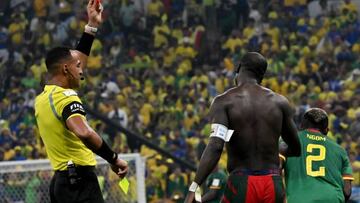What happens in soccer if the goalkeeper gets a red card?
When a player gets sent off in soccer, you are at a significant disadvantage, but when that player is your last line of defense, things get complicated quickly


There are lots of reasons why soccer has traditionally had a tough time catching on with American audiences. And while a lot of focus has been given to the obvious things like the propensity for diving in soccer that is seen as imminently shameful to Americans, laying bare soccer’s win-at-all-costs attitude that is anathema to our national sense of honor.
But perhaps the biggest impediment to the wholesale adoption of the sport by Americans is more fundamental. Soccer has as its prime element the concept of “flow”, with play continuing in an uninterrupted series of crescendoes and nadirs, while American sports revolve around tactics.
In American sports, we are used to individual plays having a beginning, a middle, and, crucially, an end. Football’s four-down structure, or baseball’s three-strike rhythm, or the shot-clock forcing basketball to move from back court to front. All of these things place a short, finite time on the tactic being put into play, before the team regroups and tries another angle.
Replacements are sent on at will in an almost limitless flow of talent from the sidelines to the field. Baseball has a very wide amount of space between the limits of who can and cannot be replaced and even these often chafe at Americans’ sensibilities.
Vincent Aboubackar scores the winner for Cameroon against Brazil.
— ESPN FC (@ESPNFC) December 2, 2022
Then gets a red card for taking off his shirt to celebrate.
What a send off 😅 pic.twitter.com/7uwV6FJz8n
So soccer, with only five substitutes allowed, is seen as unacceptably onerous, even though this is a huge amount of change over the previous amount.
History of substitutes in soccer
Back when I was a child, in the seventies and early eighties, there was only one substitute allowed in soccer, meaning that if you did not start the game, you were not likely to get in at all. In 1988, the laws of the game were changed to allow two substitutes, a situation which was clearly not adequate and in 1994 became two plus one goalkeeper before changing again the following year to become three substitutions.
And there the game stayed for fifteen years, despite fiddling around the edges with the concept of allowing further substitutes in extra time, which never really caught on.
The covid pandemic made it obvious that more substitutes would be desirable and in 2020, the laws were changed again to allow for five substitutes. This was thought to be a temporary measure, but has proven to be popular for several reasons, not the least of which is that it allows larger clubs to keep more big talent happy with their playing time.
I had to give him a red card pic.twitter.com/FGWufEVcUo
— Anthony taylor (@anthony_tay___) November 28, 2022
Red Cards can not be substituted
The red card is another unusual element to American eyes. In any of our big sports, an ejected player can be replaced, be that in football, baseball, or basketball. The concept of forcing a team to play with one less player is one that takes time to get used to.
But in soccer, even if you still have all five of your substitutions in hand, a player shown a red card can not be replaced. The card penalizes the player, in that they are ejected and must miss the following game, as well as the team, by forcing them to play the rest of that game, quite literally, with one hand tied behind their back.
When this happens, it is disastrous for any team. When the player who is shown a red card is the goalkeeper, things get infinitely more complicated.
Unlike an outfield player whose loss can simply be absorbed by the remaining players, generally by shifting formation, from say a 4-4-2 into a 4-4-1 or a 5-3-1 if the player is a defender. But the goalkeepeer means that you absolutely must get another goalkeeper in the goal. It is far too specialized a position to be left to inexperienced hands.
Generally this means sacrificing an attacker and subbing on a backup goalkeeper for him. Then with a shift of personnel, you are prepared to meet the inevitable onslaught that comes from being one man down.
#Safemoon The name of the Wales goalkeeper is Henessey and he is the first player to be issued a red card in this World Cup. When Qatar said no alcohol in the stadium they meant it.😂😂😂 pic.twitter.com/Bp1yemvaHB
— SafemoonGhana (@SafemoonGhana) November 28, 2022
Related stories
Many teams will “park the bus” in front of the goal, meaning that they will switch to a 5-4 formation and simply play for the draw, although this is not always the best tactic, particularly if you are facing a desperate opponent who will commit numbers forward and leave themselves open to the counter strike.
No matter what you do, losing a player is bad, but losing your keeper is often fatal. If you can come through this unscathed then you have a real shot at dealing with anything.

